2006 NISSAN MURANO tire pressure
[x] Cancel search: tire pressurePage 23 of 55
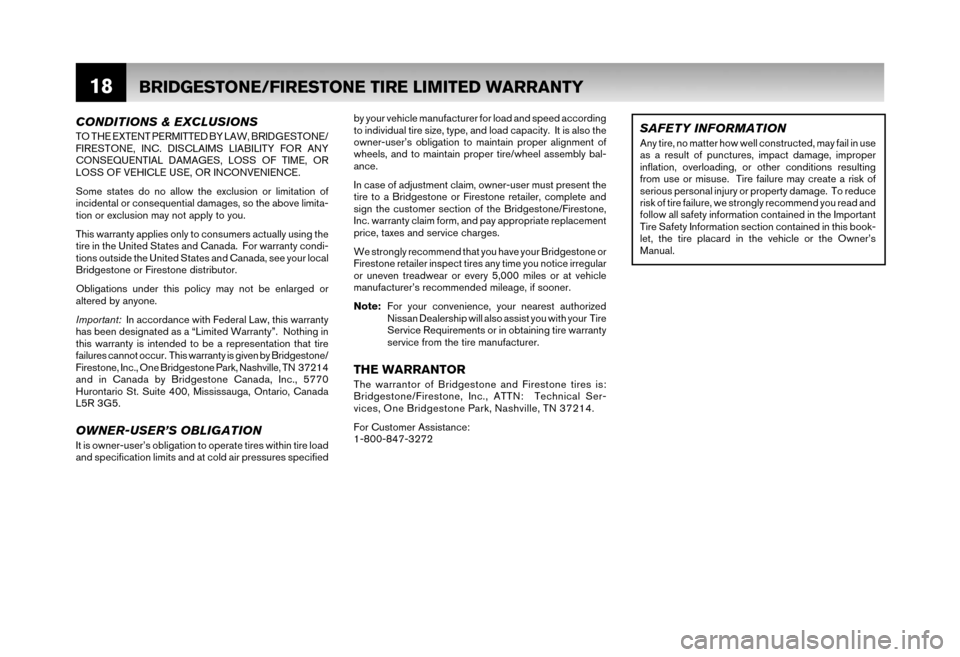
18
CONDITIONS & EXCLUSIONS
TO THE EXTENT PERMITTED BY LAW, BRIDGESTONE/
FIRESTONE, INC. DISCLAIMS LIABILITY FOR ANY
CONSEQUENTIAL DAMAGES, LOSS OF TIME, OR
LOSS OF VEHICLE USE, OR INCONVENIENCE.
Some states do no allow the exclusion or limitation of
incidental or consequential damages, so the above limita-
tion or exclusion may not apply to you.
This warranty applies only to consumers actually using the
tire in the United States and Canada. For warranty condi-
tions outside the United States and Canada, see your local
Bridgestone or Firestone distributor.
Obligations under this policy may not be enlarged or
altered by anyone.
Important: In accordance with Federal Law, this warranty
has been designated as a “Limited Warranty”. Nothing in
this warranty is intended to be a representation that tire
failures cannot occur. This warranty is given by Bridgestone/
Firestone, Inc., One Bridgestone Park, Nashville, TN 37214
and in Canada by Bridgestone Canada, Inc., 5770
Hurontario St. Suite 400, Mississauga, Ontario, Canada
L5R 3G5.
OWNER-USER’S OBLIGATIONIt is owner-user’s obligation to operate tires within tire load
and specification limits and at cold air pressures specified by your vehicle manufacturer for load and speed according
to individual tire size, type, and load capacity. It is also the
owner-user’s obligation to maintain proper alignment of
wheels, and to maintain proper tire/wheel assembly bal-
ance.
In case of adjustment claim, owner-user must present the
tire to a Bridgestone or Firestone retailer, complete and
sign the customer section of the Bridgestone/Firestone,
Inc. warranty claim form, and pay appropriate replacement
price, taxes and service charges.
We strongly recommend that you have your Bridgestone or
Firestone retailer inspect tires any time you notice irregular
or uneven treadwear or every 5,000 miles or at vehicle
manufacturer’s recommended mileage, if sooner.
Note:
For your convenience, your nearest authorized
Nissan Dealership will also assist you with your Tire
Service Requirements or in obtaining tire warranty
service from the tire manufacturer.
THE WARRANTORThe warrantor of Bridgestone and Firestone tires is:
Bridgestone/Firestone, Inc., ATTN: Technical Ser-
vices, One Bridgestone Park, Nashville, TN 37214.
For Customer Assistance:
1-800-847-3272
SAFETY INFORMATIONAny tire, no matter how well constructed, may fail in use
as a result of punctures, impact damage, improper
inflation, overloading, or other conditions resulting
from use or misuse. Tire failure may create a risk of
serious personal injury or property damage. To reduce
risk of tire failure, we strongly recommend you read and
follow all safety information contained in the Important
Tire Safety Information section contained in this book-
let, the tire placard in the vehicle or the Owner’s
Manual.
BRIDGESTONE/FIRESTONE TIRE LIMITED WARRANTY
Page 25 of 55
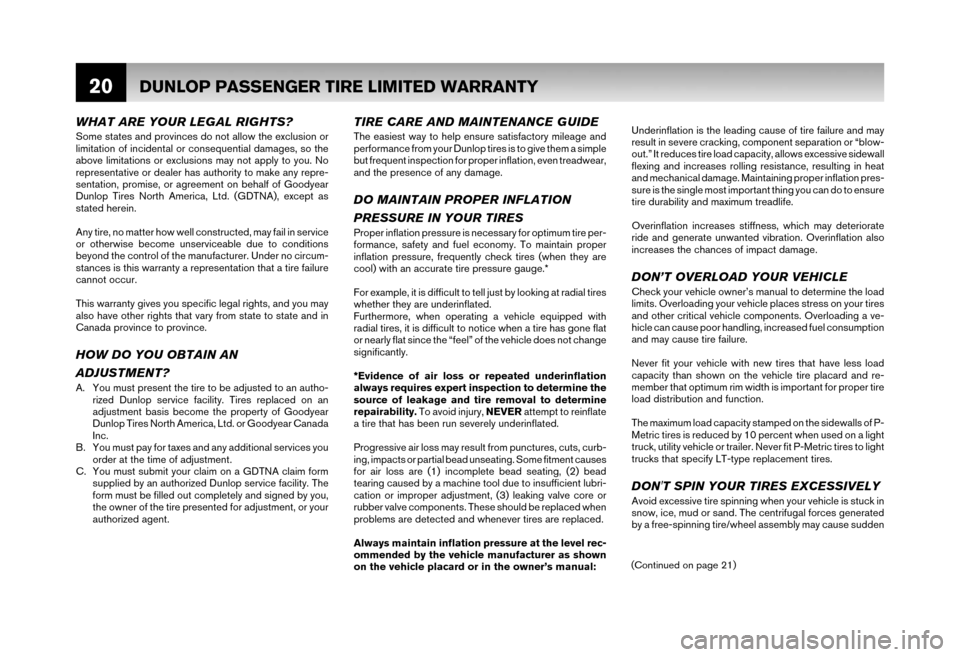
20DUNLOP PASSENGER TIRE LIMITED WARRANTY
WHAT ARE YOUR LEGAL RIGHTS?
Some states and provinces do not allow the exclusion or
limitation of incidental or consequential damages, so the
above limitations or exclusions may not apply to you. No
representative or dealer has authority to make any repre-
sentation, promise, or agreement on behalf of Goodyear
Dunlop Tires North America, Ltd. (GDTNA), except as
stated herein.
Any tire, no matter how well constructed, may fail in service
or otherwise become unserviceable due to conditions
beyond the control of the manufacturer. Under no circum-
stances is this warranty a representation that a tire failure
cannot occur.
This warranty gives you specific legal rights, and you may
also have other rights that vary from state to state and in
Canada province to province.
HOW DO YOU OBTAIN AN
ADJUSTMENT?
A. You must present the tire to be adjusted to an autho- rized Dunlop service facility. Tires replaced on an
adjustment basis become the property of Goodyear
Dunlop Tires North America, Ltd. or Goodyear Canada
Inc.
B. You must pay for taxes and any additional services you order at the time of adjustment.
C. You must submit your claim on a GDTNA claim form supplied by an authorized Dunlop service facility. The
form must be filled out completely and signed by you,
the owner of the tire presented for adjustment, or your
authorized agent.
TIRE CARE AND MAINTENANCE GUIDE
The easiest way to help ensure satisfactory mileage and
performance from your Dunlop tires is to give them a simple
but frequent inspection for proper inflation, even treadwear,
and the presence of any damage.
DO MAINTAIN PROPER INFLATION
PRESSURE IN YOUR TIRES
Proper inflation pressure is necessary for optimum tire per-
formance, safety and fuel economy. To maintain proper
inflation pressure, frequently check tires (when they are
cool) with an accurate tire pressure gauge.*
For example, it is difficult to tell just by looking at radial tires
whether they are underinflated.
Furthermore, when operating a vehicle equipped with
radial tires, it is difficult to notice when a tire has gone flat
or nearly flat since the “feel” of the vehicle does not change
significantly.
*Evidence of air loss or repeated underinflation
always requires expert inspection to determine the
source of leakage and tire removal to determine
repairability. To avoid injury, NEVER attempt to reinflate
a tire that has been run severely underinflated.
Progressive air loss may result from punctures, cuts, curb-
ing, impacts or partial bead unseating. Some fitment causes
for air loss are (1) incomplete bead seating, (2) bead
tearing caused by a machine tool due to insufficient lubri-
cation or improper adjustment, (3) leaking valve core or
rubber valve components. These should be replaced when
problems are detected and whenever tires are replaced.
Always maintain inflation pressure at the level rec-
ommended by the vehicle manufacturer as shown
on the vehicle placard or in the owner’s manual: Underinflation is the leading cause of tire failure and may
result in severe cracking, component separation or “blow-
out.” It reduces tire load capacity, allows excessive sidewall
flexing and increases rolling resistance, resulting in heat
and mechanical damage. Maintaining proper inflation pres-
sure is the single most important thing you can do to ensure
tire durability and maximum treadlife.
Overinflation increases stiffness, which may deteriorate
ride and generate unwanted vibration. Overinflation also
increases the chances of impact damage.
DON’T OVERLOAD YOUR VEHICLECheck your vehicle owner’s manual to determine the load
limits. Overloading your vehicle places stress on your tires
and other critical vehicle components. Overloading a ve-
hicle can cause poor handling, increased fuel consumption
and may cause tire failure.
Never fit your vehicle with new tires that have less load
capacity than shown on the vehicle tire placard and re-
member that optimum rim width is important for proper tire
load distribution and function.
The maximum load capacity stamped on the sidewalls of P-
Metric tires is reduced by 10 percent when used on a light
truck, utility vehicle or trailer. Never fit P-Metric tires to light
trucks that specify LT-type replacement tires.
DON'T SPIN YOUR TIRES EXCESSIVELY
Avoid excessive tire spinning when your vehicle is stuck in
snow, ice, mud or sand. The centrifugal forces generated
by a free-spinning tire/wheel assembly may cause sudden
(Continued on page 21)
Page 26 of 55
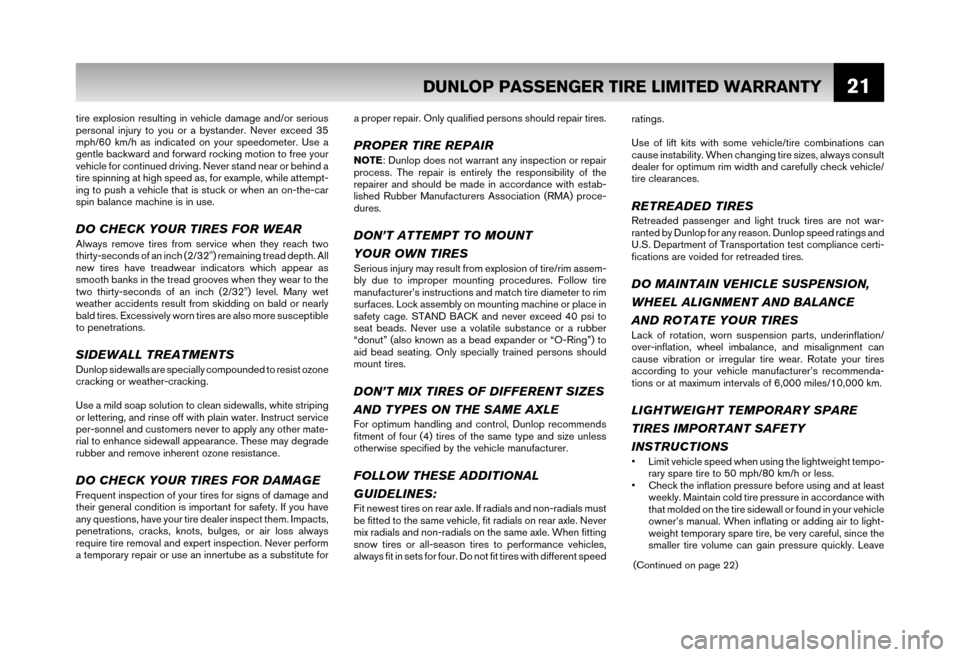
21
tire explosion resulting in vehicle damage and/or serious
personal injury to you or a bystander. Never exceed 35
mph/60 km/h as indicated on your speedometer. Use a
gentle backward and forward rocking motion to free your
vehicle for continued driving. Never stand near or behind a
tire spinning at high speed as, for example, while attempt-
ing to push a vehicle that is stuck or when an on-the-car
spin balance machine is in use.
DO CHECK YOUR TIRES FOR WEAR
Always remove tires from service when they reach two
thirty-seconds of an inch (2/32") remaining tread depth. All
new tires have treadwear indicators which appear as
smooth banks in the tread grooves when they wear to the
two thirty-seconds of an inch (2/32") level. Many wet
weather accidents result from skidding on bald or nearly
bald tires. Excessively worn tires are also more susceptible
to penetrations.
SIDEWALL TREATMENTSDunlop sidewalls are specially compounded to resist ozone
cracking or weather-cracking.
Use a mild soap solution to clean sidewalls, white striping
or lettering, and rinse off with plain water. Instruct service
per-sonnel and customers never to apply any other mate-
rial to enhance sidewall appearance. These may degrade
rubber and remove inherent ozone resistance.
DO CHECK YOUR TIRES FOR DAMAGEFrequent inspection of your tires for signs of damage and
their general condition is important for safety. If you have
any questions, have your tire dealer inspect them. Impacts,
penetrations, cracks, knots, bulges, or air loss always
require tire removal and expert inspection. Never perform
a temporary repair or use an innertube as a substitute for a proper repair. Only qualified persons should repair tires.
PROPER TIRE REPAIRNOTE
: Dunlop does not warrant any inspection or repair
process. The repair is entirely the responsibility of the
repairer and should be made in accordance with estab-
lished Rubber Manufacturers Association (RMA) proce-
dures.
DON’T ATTEMPT TO MOUNT
YOUR OWN TIRES
Serious injury may result from explosion of tire/rim assem-
bly due to improper mounting procedures. Follow tire
manufacturer’s instructions and match tire diameter to rim
surfaces. Lock assembly on mounting machine or place in
safety cage. STAND BACK and never exceed 40 psi to
seat beads. Never use a volatile substance or a rubber
“donut” (also known as a bead expander or “O-Ring”) to
aid bead seating. Only specially trained persons should
mount tires.
DON’T MIX TIRES OF DIFFERENT SIZES
AND TYPES ON THE SAME AXLE
For optimum handling and control, Dunlop recommends
fitment of four (4) tires of the same type and size unless
otherwise specified by the vehicle manufacturer.
FOLLOW THESE ADDITIONAL
GUIDELINES:
Fit newest tires on rear axle. If radials and non-radials must
be fitted to the same vehicle, fit radials on rear axle. Never
mix radials and non-radials on the same axle. When fitting
snow tires or all-season tires to performance vehicles,
always fit in sets for four. Do not fit tires with different speed ratings.
Use of lift kits with some vehicle/tire combinations can
cause instability. When changing tire sizes, always consult
dealer for optimum rim width and carefully check vehicle/
tire clearances.
RETREADED TIRESRetreaded passenger and light truck tires are not war-
ranted by Dunlop for any reason. Dunlop speed ratings and
U.S. Department of Transportation test compliance certi-
fications are voided for retreaded tires.
DO MAINTAIN VEHICLE SUSPENSION,
WHEEL ALIGNMENT AND BALANCE
AND ROTATE YOUR TIRES
Lack of rotation, worn suspension parts, underinflation/
over-inflation, wheel imbalance, and misalignment can
cause vibration or irregular tire wear. Rotate your tires
according to your vehicle manufacturer’s recommenda-
tions or at maximum intervals of 6,000 miles/10,000 km.
LIGHTWEIGHT TEMPORARY SPARE
TIRES IMPORTANT SAFETY
INSTRUCTIONS
• Limit vehicle speed when using the lightweight tempo-
rary spare tire to 50 mph/80 km/h or less.
• Check the inflation pressure before using and at least weekly. Maintain cold tire pressure in accordance with
that molded on the tire sidewall or found in your vehicle
owner’s manual. When inflating or adding air to light-
weight temporary spare tire, be very careful, since the
smaller tire volume can gain pressure quickly. Leave
DUNLOP PASSENGER TIRE LIMITED WARRANTY
(Continued on page 22)
Page 27 of 55
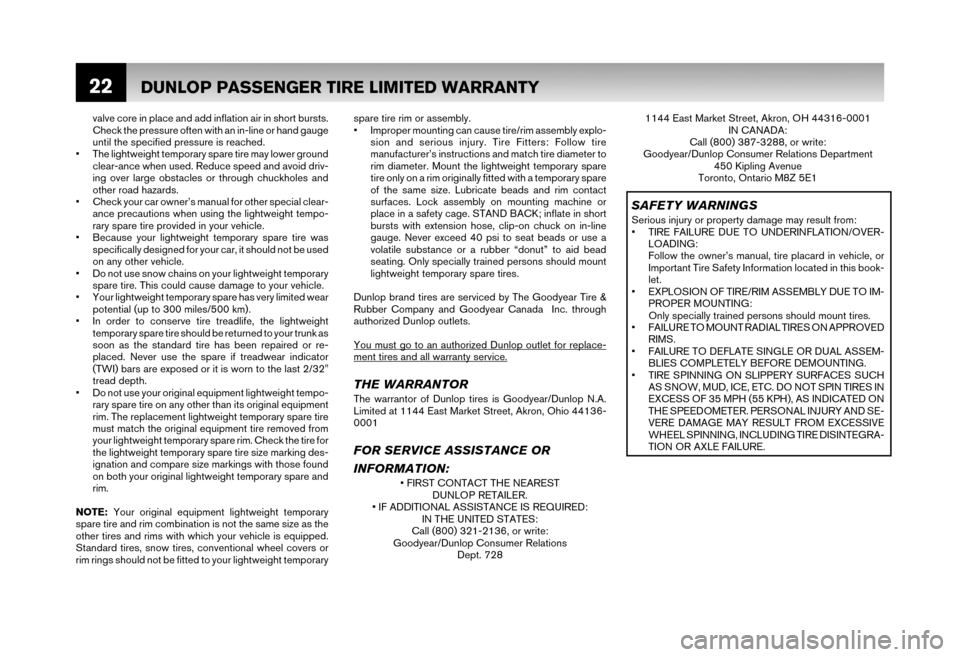
22
valve core in place and add inflation air in short bursts.
Check the pressure often with an in-line or hand gauge
until the specified pressure is reached.
• The lightweight temporary spare tire may lower ground
clear-ance when used. Reduce speed and avoid driv-
ing over large obstacles or through chuckholes and
other road hazards.
• Check your car owner’s manual for other special clear- ance precautions when using the lightweight tempo-
rary spare tire provided in your vehicle.
• Because your lightweight temporary spare tire was specifically designed for your car, it should not be used
on any other vehicle.
• Do not use snow chains on your lightweight temporary spare tire. This could cause damage to your vehicle.
• Your lightweight temporary spare has very limited wear
potential (up to 300 miles/500 km).
• In order to conserve tire treadlife, the lightweight temporary spare tire should be returned to your trunk as
soon as the standard tire has been repaired or re-
placed. Never use the spare if treadwear indicator
(TWI) bars are exposed or it is worn to the last 2/32"
tread depth.
• Do not use your original equipment lightweight tempo- rary spare tire on any other than its original equipment
rim. The replacement lightweight temporary spare tire
must match the original equipment tire removed from
your lightweight temporary spare rim. Check the tire for
the lightweight temporary spare tire size marking des-
ignation and compare size markings with those found
on both your original lightweight temporary spare and
rim.
NOTE: Your original equipment lightweight temporary
spare tire and rim combination is not the same size as the
other tires and rims with which your vehicle is equipped.
Standard tires, snow tires, conventional wheel covers or
rim rings should not be fitted to your lightweight temporary
DUNLOP PASSENGER TIRE LIMITED WARRANTY
spare tire rim or assembly.
• Improper mounting can cause tire/rim assembly explo- sion and serious injury. Tire Fitters: Follow tire
manufacturer’s instructions and match tire diameter to
rim diameter. Mount the lightweight temporary spare
tire only on a rim originally fitted with a temporary spare
of the same size. Lubricate beads and rim contact
surfaces. Lock assembly on mounting machine or
place in a safety cage. STAND BACK; inflate in short
bursts with extension hose, clip-on chuck on in-line
gauge. Never exceed 40 psi to seat beads or use a
volatile substance or a rubber “donut” to aid bead
seating. Only specially trained persons should mount
lightweight temporary spare tires.
Dunlop brand tires are serviced by The Goodyear Tire &
Rubber Company and Goodyear Canada Inc. through
authorized Dunlop outlets.
You must go to an authorized Dunlop outlet for replace-ment tires and all warranty service.
THE WARRANTORThe warrantor of Dunlop tires is Goodyear/Dunlop N.A.
Limited at 1144 East Market Street, Akron, Ohio 44136-
0001
FOR SERVICE ASSISTANCE OR
INFORMATION:
• FIRST CONTACT THE NEAREST DUNLOP RETAILER.
• IF ADDITIONAL ASSISTANCE IS REQUIRED: IN THE UNITED STATES:
Call (800) 321-2136, or write:
Goodyear/Dunlop Consumer Relations Dept. 728 1144 East Market Street, Akron, OH 44316-0001
IN CANADA:
Call (800) 387-3288, or write:
Goodyear/Dunlop Consumer Relations Department
450 Kipling Avenue
Toronto, Ontario M8Z 5E1
SAFETY WARNINGSSerious injury or property damage may result from:
• TIRE FAILURE DUE TO UNDERINFLATION/OVER-
LOADING:
Follow the owner’s manual, tire placard in vehicle, or
Important Tire Safety Information located in this book-
let.
• EXPLOSION OF TIRE/RIM ASSEMBLY DUE TO IM- PROPER MOUNTING:
Only specially trained persons should mount tires.
• FAILURE TO MOUNT RADIAL TIRES ON APPROVED RIMS.
• FAILURE TO DEFLATE SINGLE OR DUAL ASSEM- BLIES COMPLETELY BEFORE DEMOUNTING.
• TIRE SPINNING ON SLIPPERY SURFACES SUCH
AS SNOW, MUD, ICE, ETC. DO NOT SPIN TIRES IN
EXCESS OF 35 MPH (55 KPH), AS INDICATED ON
THE SPEEDOMETER. PERSONAL INJURY AND SE-
VERE DAMAGE MAY RESULT FROM EXCESSIVE
WHEEL SPINNING, INCLUDING TIRE DISINTEGRA-
TION OR AXLE FAILURE.
Page 36 of 55
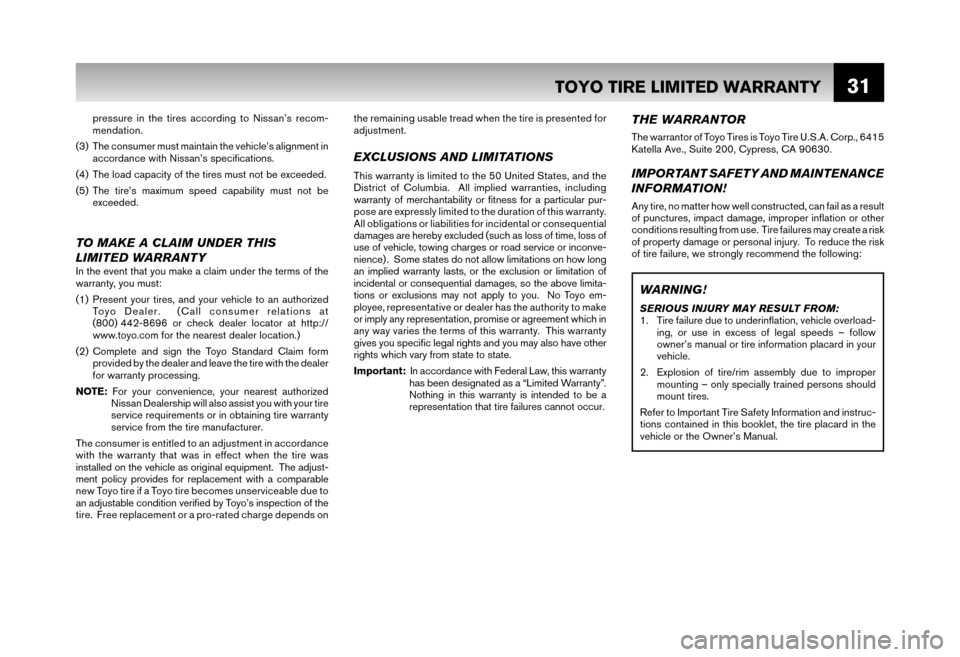
31
THE WARRANTOR
The warrantor of Toyo Tires is Toyo Tire U.S.A. Corp., 6415
Katella Ave., Suite 200, Cypress, CA 90630.
IMPORTANT SAFETY AND MAINTENANCE
INFORMATION!
Any tire, no matter how well constructed, can fail as a result
of punctures, impact damage, improper inflation or other
conditions resulting from use. Tire failures may create a risk
of property damage or personal injury. To reduce the risk
of tire failure, we strongly recommend the following:
WARNING!
SERIOUS INJURY MAY RESULT FROM:
1. Tire failure due to underinflation, vehicle overload- ing, or use in excess of legal speeds – follow
owner’s manual or tire information placard in your
vehicle.
2. Explosion of tire/rim assembly due to improper mounting – only specially trained persons should
mount tires.
Refer to Important Tire Safety Information and instruc-
tions contained in this booklet, the tire placard in the
vehicle or the Owner’s Manual.
TOYO TIRE LIMITED WARRANTY
pressure in the tires according to Nissan’s recom-
mendation.
(3) The consumer must maintain the vehicle’s alignment in accordance with Nissan’s specifications.
(4) The load capacity of the tires must not be exceeded.
(5) The tire’s maximum speed capability must not be exceeded.
TO MAKE A CLAIM UNDER THIS
LIMITED WARRANTY
In the event that you make a claim under the terms of the
warranty, you must:
(1) Present your tires, and your vehicle to an authorized
Toyo Dealer. (Call consumer relations at
(800) 442-8696 or check dealer locator at http://
www.toyo.com for the nearest dealer location.)
(2) Complete and sign the Toyo Standard Claim form provided by the dealer and leave the tire with the dealer
for warranty processing.
NOTE: For your convenience, your nearest authorized Nissan Dealership will also assist you with your tire
service requirements or in obtaining tire warranty
service from the tire manufacturer.
The consumer is entitled to an adjustment in accordance
with the warranty that was in effect when the tire was
installed on the vehicle as original equipment. The adjust-
ment policy provides for replacement with a comparable
new Toyo tire if a Toyo tire becomes unserviceable due to
an adjustable condition verified by Toyo’s inspection of the
tire. Free replacement or a pro-rated charge depends on the remaining usable tread when the tire is presented for
adjustment.
EXCLUSIONS AND LIMITATIONS
This warranty is limited to the 50 United States, and the
District of Columbia. All implied warranties, including
warranty of merchantability or fitness for a particular pur-
pose are expressly limited to the duration of this warranty.
All obligations or liabilities for incidental or consequential
damages are hereby excluded (such as loss of time, loss of
use of vehicle, towing charges or road service or inconve-
nience) . Some states do not allow limitations on how long
an implied warranty lasts, or the exclusion or limitation of
incidental or consequential damages, so the above limita-
tions or exclusions may not apply to you. No Toyo em-
ployee,
representative or dealer has the authority to make
or imply any representation, promise or agreement which in
any way varies the terms of this warranty. This warranty
gives you specific legal rights and you may also have other
rights which vary from state to state.
Important: In accordance with Federal Law, this warranty
has been designated as a “Limited Warranty”.
Nothing in this warranty is intended to be a
representation that tire failures cannot occur.
Page 38 of 55
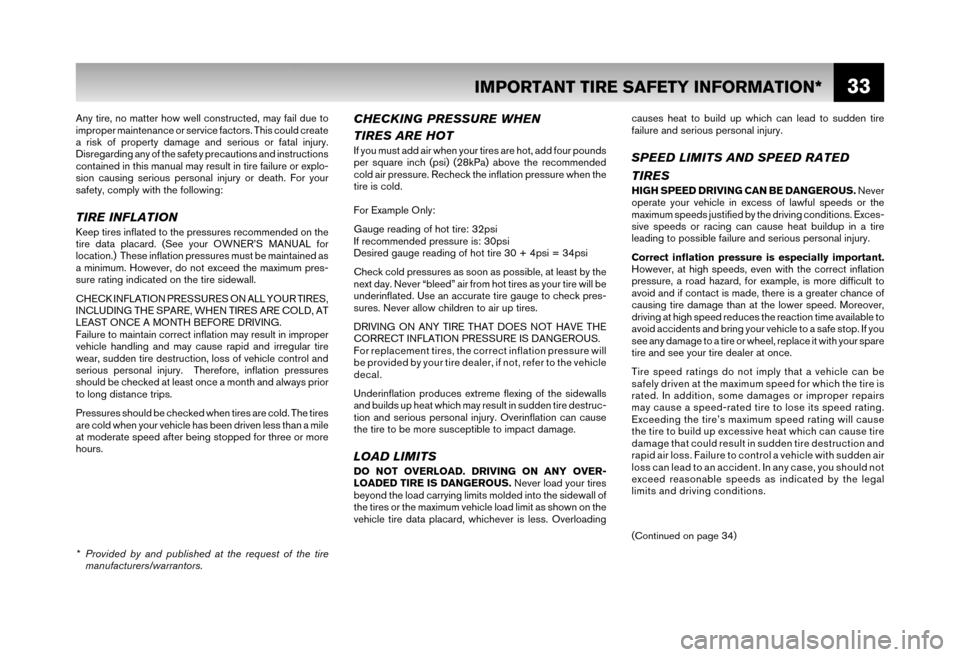
33
Any tire, no matter how well constructed, may fail due to
improper maintenance or service factors. This could create
a risk of property damage and serious or fatal injury.
Disregarding any of the safety precautions and instructions
contained in this manual may result in tire failure or explo-
sion causing serious personal injury or death. For your
safety, comply with the following:
TIRE INFLATIONKeep tires inflated to the pressures recommended on the
tire data placard. (See your OWNER’S MANUAL for
location.) These inflation pressures must be maintained as
a minimum. However, do not exceed the maximum pres-
sure rating indicated on the tire sidewall.
CHECK INFLATION PRESSURES ON ALL YOUR TIRES,
INCLUDING THE SPARE, WHEN TIRES ARE COLD, AT
LEAST ONCE A MONTH BEFORE DRIVING.
Failure to maintain correct inflation may result in improper
vehicle handling and may cause rapid and irregular tire
wear, sudden tire destruction, loss of vehicle control and
serious personal injury. Therefore, inflation pressures
should be checked at least once a month and always prior
to long distance trips.
Pressures should be checked when tires are cold. The tires
are cold when your vehicle has been driven less than a mile
at moderate speed after being stopped for three or more
hours.
CHECKING PRESSURE WHEN
TIRES ARE HOT
If you must add air when your tires are hot, add four pounds
per square inch (psi) (28kPa) above the recommended
cold air pressure. Recheck the inflation pressure when the
tire is cold.
For Example Only:
Gauge reading of hot tire: 32psi
If recommended pressure is: 30psi
Desired gauge reading of hot tire 30 + 4psi = 34psi
Check cold pressures as soon as possible, at least by the
next day. Never “bleed” air from hot tires as your tire will be
underinflated. Use an accurate tire gauge to check pres-
sures. Never allow children to air up tires.
DRIVING ON ANY TIRE THAT DOES NOT HAVE THE
CORRECT INFLATION PRESSURE IS DANGEROUS.
For replacement tires, the correct inflation pressure will
be provided by your tire dealer, if not, refer to the vehicle
decal.
Underinflation produces extreme flexing of the sidewalls
and builds up heat which may result in sudden tire destruc-
tion and serious personal injury. Overinflation can cause
the tire to be more susceptible to impact damage.
LOAD LIMITS
DO NOT OVERLOAD. DRIVING ON ANY OVER-
LOADED TIRE IS DANGEROUS. Never load your tires
beyond the load carrying limits molded into the sidewall of
the tires or the maximum vehicle load limit as shown on the
vehicle tire data placard, whichever is less. Overloading causes heat to build up which can lead to sudden tire
failure and serious personal injury.
SPEED LIMITS AND SPEED RATED
TIRES
HIGH SPEED DRIVING CAN BE DANGEROUS.
Never
operate your vehicle in excess of lawful speeds or the
maximum speeds justified by the driving conditions. Exces-
sive speeds or racing can cause heat buildup in a tire
leading to possible failure and serious personal injury.
Correct inflation pressure is especially important.
However, at high speeds, even with the correct inflation
pressure, a road hazard, for example, is more difficult to
avoid and if contact is made, there is a greater chance of
causing tire damage than at the lower speed. Moreover,
driving at high speed reduces the reaction time available to
avoid accidents and bring your vehicle to a safe stop. If you
see any damage to a tire or wheel, replace it with your spare
tire and see your tire dealer at once.
Tire speed ratings do not imply that a vehicle can be
safely driven at the maximum speed for which the tire is
rated. In addition, some damages or improper repairs
may cause a speed-rated tire to lose its speed rating.
Exceeding the tire’s maximum speed rating will cause
the tire to build up excessive heat which can cause tire
damage that could result in sudden tire destruction and
rapid air loss. Failure to control a vehicle with sudden air
loss can lead to an accident. In any case, you should not
exceed reasonable speeds as indicated by the legal
limits and driving conditions.
* Provided by and published at the request of the tire manufacturers/warrantors.
IMPORTANT TIRE SAFETY INFORMATION*
(Continued on page 34)
Page 39 of 55
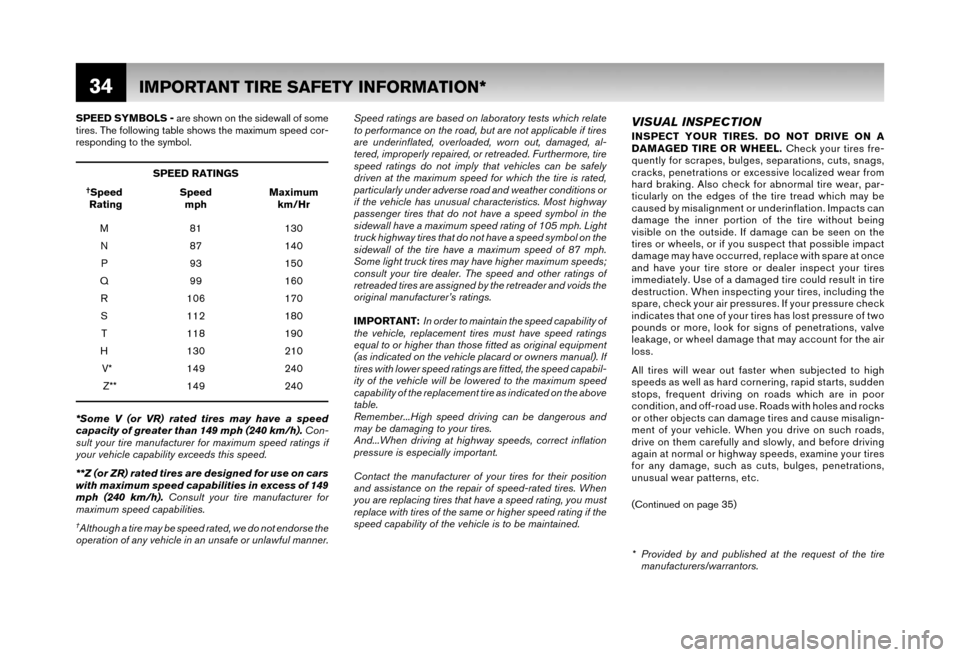
34
SPEED SYMBOLS - are shown on the sidewall of some
tires. The following table shows the maximum speed cor-
responding to the symbol.
SPEED RATINGS
†Speed Speed Maximum
Rating mph km/Hr
M 81 130 N 87 140 P 93 150
Q 99 160 R 106 170
S 112 180 T 118 190
H 130 210
V* 149 240
Z** 149 240
*Some V (or VR) rated tires may have a speed
capacity of greater than 149 mph (240 km/h). Con-
sult your tire manufacturer for maximum speed ratings if
your vehicle capability exceeds this speed.
**Z (or ZR) rated tires are designed for use on cars
with maximum speed capabilities in excess of 149
mph (240 km/h). Consult your tire manufacturer for
maximum speed capabilities.
†Although a tire may be speed rated, we do not endorse the
operation of any vehicle in an unsafe or unlawful manner. Speed ratings are based on laboratory tests which relate
to performance on the road, but are not applicable if tires
are underinflated, overloaded, worn out, damaged, al-
tered, improperly repaired, or retreaded. Furthermore, tire
speed ratings do not imply that vehicles can be safely
driven at the maximum speed for which the tire is rated,
particularly under adverse road and weather conditions or
if the vehicle has unusual characteristics. Most highway
passenger tires that do not have a speed symbol in the
sidewall have a maximum speed rating of 105 mph. Light
truck highway tires that do not have a speed symbol on the
sidewall of the tire have a maximum speed of 87 mph.
Some light truck tires may have higher maximum speeds;
consult your tire dealer. The speed and other ratings of
retreaded tires are assigned by the retreader and voids the
original manufacturer’s ratings.
IMPORTANT:
In order to maintain the speed capability of
the vehicle, replacement tires must have speed ratings
equal to or higher than those fitted as original equipment
(as indicated on the vehicle placard or owners manual). If
tires with lower speed ratings are fitted, the speed capabil-
ity of the vehicle will be lowered to the maximum speed
capability of the replacement tire as indicated on the above
table.
Remember...High speed driving can be dangerous and
may be damaging to your tires.
And...When driving at highway speeds, correct inflation
pressure is especially important.
Contact the manufacturer of your tires for their position
and assistance on the repair of speed-rated tires. When
you are replacing tires that have a speed rating, you must
replace with tires of the same or higher speed rating if the
speed capability of the vehicle is to be maintained.
VISUAL INSPECTION
INSPECT YOUR TIRES. DO NOT DRIVE ON A
DAMAGED TIRE OR WHEEL. Check your tires fre-
quently for scrapes, bulges, separations, cuts, snags,
cracks, penetrations or excessive localized wear from
hard braking. Also check for abnormal tire wear, par-
ticularly on the edges of the tire tread which may be
caused by misalignment or underinflation. Impacts can
damage the inner portion of the tire without being
visible on the outside. If damage can be seen on the
tires or wheels, or if you suspect that possible impact
damage may have occurred, replace with spare at once
and have your tire store or dealer inspect your tires
immediately. Use of a damaged tire could result in tire
destruction. When inspecting your tires, including the
spare, check your air pressures. If your pressure check
indicates that one of your tires has lost pressure of two
pounds or more, look for signs of penetrations, valve
leakage, or wheel damage that may account for the air
loss.
All tires will wear out faster when subjected to high
speeds as well as hard cornering, rapid starts, sudden
stops, frequent driving on roads which are in poor
condition, and off-road use. Roads with holes and rocks
or other objects can damage tires and cause misalign-
ment of your vehicle. When you drive on such roads,
drive on them carefully and slowly, and before driving
again at normal or highway speeds, examine your tires
for any damage, such as cuts, bulges, penetrations,
unusual wear patterns, etc.
* Provided by and published at the request of the tire
manufacturers/warrantors.
IMPORTANT TIRE SAFETY INFORMATION*
(Continued on page 35)
Page 42 of 55
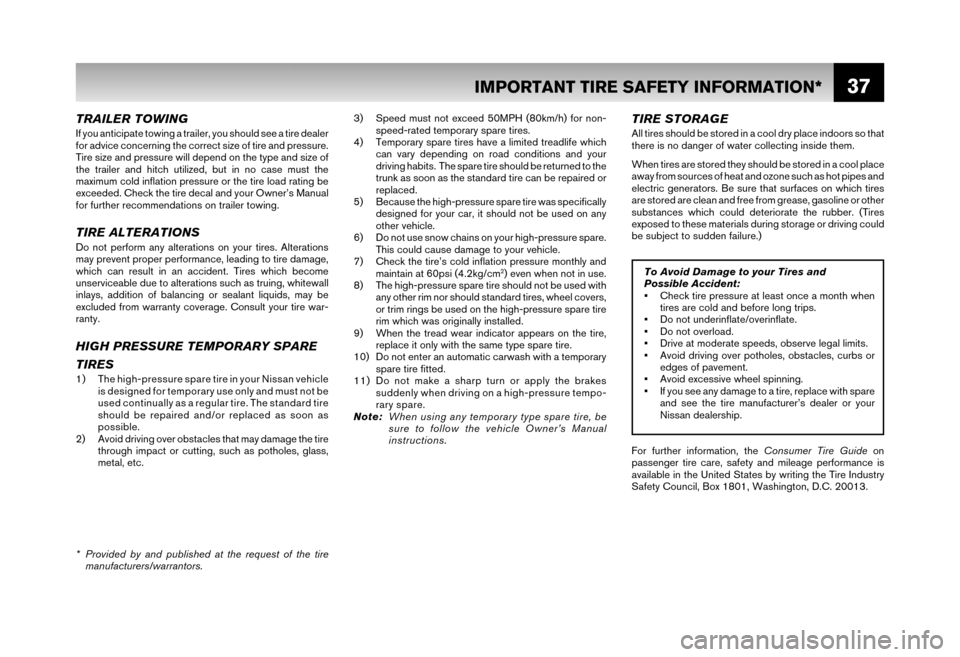
37
TRAILER TOWINGIf you anticipate towing a trailer, you should see a tire dealer
for advice concerning the correct size of tire and pressure.
Tire size and pressure will depend on the type and size of
the trailer and hitch utilized, but in no case must the
maximum cold inflation pressure or the tire load rating be
exceeded. Check the tire decal and your Owner’s Manual
for further recommendations on trailer towing.
TIRE ALTERATIONSDo not perform any alterations on your tires. Alterations
may prevent proper performance, leading to tire damage,
which can result in an accident. Tires which become
unserviceable due to alterations such as truing, whitewall
inlays, addition of balancing or sealant liquids, may be
excluded from warranty coverage. Consult your tire war-
ranty.
HIGH PRESSURE TEMPORARY SPARE
TIRES
1) The high-pressure spare tire in your Nissan vehicle is designed for temporary use only and must not be
used continually as a regular tire. The standard tire
should be repaired and/or replaced as soon as
possible.
2) Avoid driving over obstacles that may damage the tire through impact or cutting, such as potholes, glass,
metal, etc. 3) Speed must not exceed 50MPH (80km/h) for non-
speed-rated temporary spare tires.
4) Temporary spare tires have a limited treadlife which can vary depending on road conditions and your
driving habits. The spare tire should be returned to the
trunk as soon as the standard tire can be repaired or
replaced.
5) Because the high-pressure spare tire was specifically designed for your car, it should not be used on any
other vehicle.
6) Do not use snow chains on your high-pressure spare. This could cause damage to your vehicle.
7) Check the tire’s cold inflation pressure monthly and
maintain at 60psi (4.2kg/cm
2) even when not in use.
8) The high-pressure spare tire should not be used with any other rim nor should standard tires, wheel covers,
or trim rings be used on the high-pressure spare tire
rim which was originally installed.
9) When the tread wear indicator appears on the tire,
replace it only with the same type spare tire.
10) Do not enter an automatic carwash with a temporary spare tire fitted.
11) Do not make a sharp turn or apply the brakes suddenly when driving on a high-pressure tempo-
rary spare.
Note: When using any temporary type spare tire, be
sure to follow the vehicle Owner’s Manual
instructions.
TIRE STORAGEAll tires should be stored in a cool dry place indoors so that
there is no danger of water collecting inside them.
When tires are stored they should be stored in a cool place
away from sources of heat and ozone such as hot pipes and
electric generators. Be sure that surfaces on which tires
are stored are clean and free from grease, gasoline or other
substances which could deteriorate the rubber. (Tires
exposed to these materials during storage or driving could
be subject to sudden failure.)
To Avoid Damage to your Tires and
Possible Accident:
• Check tire pressure at least once a month when
tires are cold and before long trips.
• Do not underinflate/overinflate.
• Do not overload.
• Drive at moderate speeds, observe legal limits.
• Avoid driving over potholes, obstacles, curbs or
edges of pavement.
• Avoid excessive wheel spinning.
• If you see any damage to a tire, replace with spare
and see the tire manufacturer’s dealer or your
Nissan dealership.
For further information, the Consumer Tire Guide on
passenger tire care, safety and mileage performance is
available in the United States by writing the Tire Industry
Safety Council, Box 1801, Washington, D.C. 20013.
* Provided by and published at the request of the tire manufacturers/warrantors.
IMPORTANT TIRE SAFETY INFORMATION*